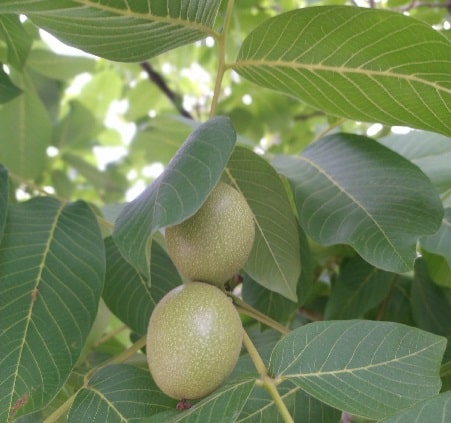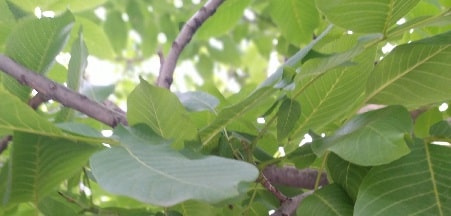Can you grow walnuts in Alberta?
Walnuts can grow in Alberta, walnut trees grow where climatic conditions are favorable. It is possible to grow walnut trees by planting walnut saplings suitable for your region. Some walnut species do not grow in every region. Although walnut trees are more adapted to valleys with sunny summers, mild winters and protected from cold winds, it is seen that they can also grow in places with harsh winters when the garden is established by taking into account the need for cooling, awakening and winter rest periods.
Walnut trees (Juglans spp.), including black walnut (Juglans nigra) and English walnut (Juglans regia), can be challenging to grow in Alberta, Canada due to the region’s climate and growing conditions. However, with proper care and site selection, it is possible to cultivate certain varieties of walnuts in select areas of Alberta. Here are some factors to consider:
- Climate: Alberta has a cool and continental climate with relatively short growing seasons. Walnut trees prefer temperate to subtropical climates. The challenge in Alberta lies in the potential for late spring frosts and shorter growing seasons, which can impact the growth and development of walnut trees.
- Hardiness: Select walnut varieties that are known to be more cold-hardy, such as ‘Carpathian’ or ‘Manregion’, which are hybrids of English walnut (Juglans regia) and black walnut (Juglans nigra). These varieties have shown better adaptability to colder climates and have been successfully grown in parts of Alberta.
- Site Selection: Choose a site that provides the walnut tree with the best chance of success. Look for a location with good sun exposure, preferably on a south-facing slope or in a sheltered microclimate that can help protect the tree from harsh winter winds and frost pockets.
- Soil: Walnut trees thrive in well-draining soils with good fertility. They prefer deep, loamy soils that are rich in organic matter. Before planting, conduct a soil test to assess the soil pH and nutrient levels. Make necessary amendments to improve soil conditions if needed.
- Irrigation: Walnut trees generally require regular watering, especially during the establishment phase. Adequate soil moisture is essential for their growth. Consider providing supplemental irrigation during dry periods, particularly in the early years.
- Protection from Wildlife: Walnuts are attractive to wildlife, including squirrels and birds. Consider using protective measures, such as tree guards or netting, to prevent damage to the tree and loss of nuts.
- Pruning and Care: Follow standard pruning practices to remove dead, damaged, or crossing branches and maintain the tree’s structure. Regular care, including mulching, fertilization, and monitoring for pests and diseases, is crucial for the tree’s overall health and productivity.

It’s important to note that growing walnuts in Alberta may still be challenging and may require additional effort and attention compared to regions with more favorable walnut-growing conditions. Consulting with local horticultural experts, agricultural extension services, or experienced growers in Alberta can provide valuable insights and recommendations specific to your location.
Is there walnut trees in Alberta?
Walnut trees (Juglans spp.) are not native to Alberta, Canada. Their natural range is primarily in the eastern and central parts of North America, although some species can be found in other parts of the world.
While walnut trees are not native to Alberta, it is possible to cultivate certain varieties in select areas of the province. However, due to Alberta’s climate and growing conditions, growing walnuts in Alberta can be challenging. The region’s cooler temperatures, short growing season, and potential for late spring frosts make it less ideal for walnut tree cultivation compared to other regions.
If you are interested in growing walnut trees in Alberta, consider selecting varieties that are known for their cold hardiness, such as ‘Carpathian’ or ‘Manregion’, which are hybrids of English walnut (Juglans regia) and black walnut (Juglans nigra). These varieties have shown better adaptability to colder climates and have been successfully grown in parts of Alberta.
Keep in mind that successful walnut cultivation in Alberta may still require careful site selection, soil preparation, and ongoing care and attention. Consulting with local experts, such as horticulturists, arborists, or agricultural extension services, can provide more specific guidance tailored to your location and increase your chances of success. Alberta walnuts >>
How to care for and prune a walnut tree in Alberta
Caring for and pruning a walnut tree in Alberta requires careful attention to the tree’s needs and the region’s specific growing conditions. Here are some guidelines to consider:

- Site Selection: Choose a location that provides the walnut tree with the best chance of success. Look for a site with good sun exposure, preferably on a south-facing slope or in a sheltered microclimate that can help protect the tree from harsh winter winds and frost pockets.
- Soil and Watering: Walnut trees prefer well-draining soil with good fertility. Ensure the soil has adequate organic matter content. Conduct a soil test to assess the pH and nutrient levels. Make necessary amendments to improve soil conditions if needed. Provide regular watering, especially during the establishment phase and dry periods, to ensure adequate soil moisture.
- Pruning: Prune walnut trees during the dormant season, typically in late fall or winter. Remove dead, damaged, or diseased branches. Thin out the canopy to improve airflow and light penetration, reducing the risk of fungal diseases. Maintain a balanced and open structure by removing crossing or competing branches. Avoid heavy pruning, as walnut trees can exhibit excessive regrowth.
- Fertilization: Walnut trees generally require minimal fertilization, especially if the soil has been properly amended prior to planting. Conduct a soil test to determine any specific nutrient deficiencies and apply fertilizer accordingly. Use a balanced fertilizer with nitrogen, phosphorus, and potassium, following the manufacturer’s instructions.
- Mulching: Apply a layer of organic mulch around the base of the tree to help conserve soil moisture, suppress weed growth, and moderate soil temperature. Leave a gap between the mulch and the trunk to prevent moisture buildup and potential rotting.
- Pest and Disease Management: Monitor the tree for pests and diseases common to walnut trees, such as walnut caterpillars, walnut husk flies, and fungal diseases like anthracnose. Follow integrated pest management practices and take appropriate measures if needed. Regularly inspect the tree for signs of infestation or disease, and consult with local experts for specific management strategies in Alberta.
- Harvesting: Black walnut trees typically start producing nuts after around 10 years. Harvest the nuts when they fall naturally from the tree and remove the husks. Allow the nuts to dry for a few weeks before cracking them open to retrieve the edible kernels.
Remember that growing walnut trees in Alberta can be challenging due to the region’s climate. Consult with local horticultural experts, agricultural extension services, or experienced growers in Alberta for personalized advice and recommendations tailored to your specific location.
When to plant walnut seedlings in Alberta?
The best time to plant walnut seedlings in Alberta is typically in the spring, after the risk of frost has passed and the soil has warmed up. Planting walnut seedlings earlier in the spring allows them to establish their root systems and adapt to the growing conditions before the onset of winter.
In general, aim to plant walnut seedlings in Alberta in late April to early June, depending on the specific location and weather conditions. This timeframe provides enough time for the seedlings to acclimate and develop strong roots before winter sets in.
When planting walnut seedlings, ensure that the soil is well-draining and prepared with organic matter. Dig a planting hole that is wide and deep enough to accommodate the root system of the seedling. Place the seedling in the hole at the same depth as it was in the nursery container or root ball. Backfill the hole with soil, gently firming it around the roots. Water the seedling thoroughly after planting to settle the soil and provide moisture.
It’s worth noting that growing walnut trees in Alberta can be challenging due to the region’s climate. Ensure you select cold-hardy varieties and follow proper care practices to give the seedlings the best chance of survival and growth. Consulting with local horticultural experts, agricultural extension services, or experienced growers in Alberta can provide valuable insights and recommendations specific to your location. Which walnut tree grows well in Alberta? >>





